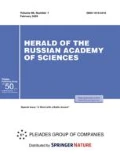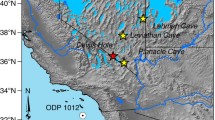Abstract
The background of the orbital theory of paleoclimate, the creation of which is not yet completed, is reviewed in the article below. Can this theory lay the foundation for the development of correct paleoclimatic models that would provide for an adequate idea about the operation of our planet’s climatic machine? The authors attempt to answer this question and outline the trend of its further improvement.
Similar content being viewed by others
References
M. Schwarzbach, Climates of the Past: An Introduction to Paleoclimatology (D. Van Nostrand, Princeton, 1963; Inostrannaya Literatura, Moscow, 1955).
J. Croll, Climate and Time in Their Geological Relations: A Theory of Secular Changes of the Earth’s Climate (Edward Stanford, London, 1875).
J. Imbrie and K. P. Imbrie, Ice Ages: Solving the Mystery (Short Hills, Enslow, 1979; Progress, Moscow, 1988).
J. A. Adhémar, Revolutions de la mer: deluges periodiques (Carilian-Goeury et V. Dalmont, Paris, 1842).
V. A. Bol’shakov, The New Concept of the Orbital Theory of Paleoclimate (Mosk. Gos. Univ., Moscow, 2003) [in Russian].
J. Croll, “On the Physical Cause of the Change of Climate during Geological Epochs,” Philos. Mag. 28, 121 (1864).
J. Croll, “On the Change in the Obliquity of the Ecliptic, Its Influence on the Climate of the Polar Regions and on the Level of the Sea,” Philos. Mag. 33, 426 (1867).
J. Imbrie, “Astronomical Theory of the Pleistocene Ice Ages: a Brief Historical Review,” Icarus 50, 408 (1982).
M. Milankovic, Mathematic Climatology and Astronomic Theory of Climatic Fluctuations, (Borntreger, Berlin, 1930; GONTI, Moscow, 1939).
J. D. Hays, J. Imbrie, and N. Shackleton, “Variation in the Earth’s Orbit: Pacemaker of the Ice Ages,” Science 194, 1121 (1976).
J. Imbrie, A. Berger, A. Boyle, et al., “On the Structure and Origin of Major Glaciation Cycles. 2. The 100 000-Year Cycle,” Paleoceanography 8, 699 (1993).
V. A. Bol’shakov and P. V. Bol’shakov, “Astronomical Theory of Paleoclimate: A New Concept, Stratigr. Geol. Korrelyatsiya 7(6), 3 (1999) [Stratigr. Geol. Correlation 7 (6), 521 (1999)].
V. A. Bol’shakov, “A New Concept of the Astronomical Theory of Paleoclimate: Two Steps Backward, One Step Forward,” Fiz. Zemli 37(11), 50 (2001) [Izv. Phys. Solid Earth 37 (11), 906 (2001)].
M. Elkibbi and J. Rial, “An Outsider’s Review of the Astronomical Theory of the Climate: Is the Eccentricity-Driven Insolation the Main Driver of the Ice Ages?,” Earth-Sci. Rev. 56, 161 (2001).
D. Paillard, “Glacial Cycles: Toward a New Paradigm,” Revs. Geophys. 39, 325 (2001).
M. E. Raymo and K. Nisancioglu, “The 41-Kyr World: Milankovitch’s Other Unsolved Mystery,” Paleoceanography 18, 1011 (2003).
L. E. Lisiecki and M. E. Raymo, “A Pliocene-Pleistocene Stack of 57 Globally Distributed Benthic δ18O Records,” Paleoceanography 20, 1003 (2005).
W. F. Ruddiman and A. McIntyre, “Oceanic Mechanisms for Amplification of the 23 000-Year Ice-Volume Cycle,” Science 212, 617 (1981).
E. S. Kandiano and H. A. Bauch, “Surface Ocean Temperatures in the Northeast Atlantic during the Last 500 000 Years: Evidence from Foraminiferal Census Data,” Terra Nova 15(4), 265 (2003).
A. L. Berger and M. F. Loutre, “Insolation Values for the Climate of the Last 10 Million Years,” Quat. Sci. Rev. 10, 297 (1991).
G. Roe, “In Defence of Milankovitch,” Geophys. Res. Lett. 33, L24703 (2006).
V. A. Bol’shakov, “Modern Climatic Data for the Pleistocene: Implications for a New Concept of the Orbital Theory of Paleoclimate,” Russ. J. Earth Sci. 5(2), 125 (2003).
Milankovitch and Climate: Understanding the Response to Astronomical Forcing, NATO ASI Series, Ed. by A. Berger et al. (Reidel, Dordrecht, 1984), Ser. C, Vol. 126.
S. Clemens and R. Tiedemann, “Eccentricity Forcing of Pliocene-Early Pleistocene Climate Revealed in a Marine Oxygen-Isotope Record,” Nature 385, 801 (1997).
V. A. Bol’shakov, “The Problem of the 11th Marine Isotope Stage from the Viewpoint of the New Conception of the Orbital Theory of the Paleoclimate,” Okeanologiya 50(2), 236 (2010) [Oceanology 50 (2), 215 (2010)].
M. Crucifix, M. Loutre, and A. Berger, “The Climate Response to the Astronomical Forcing,” Space Sci. Rev. 125, 213 (2006).
V. A. Bol’shakov, “A New Concept of the Astronomical Theory of Paleoclimate,” in Problems of the Pleistocene’s Paleogeography and Stratigraphy (Mosk. Gos. Univ., Moscow, 2000), pp. 35–69 [in Russian].
M. F. Loutre, D. Paillard, F. Vimeix, and E. Cortijo, “Does Mean Annual Insolation Have the Potential to Change the Climate?,” Earth Planet. Sci. Lett. 221, 1 (2004).
V. A. Bol’shakov, “How Long Will the ‘Precession Epoch’ Last in Terms of Pleistocene Glacial Cycles?,” Russ. J. Earth Sci. 10(3) (2008).
M. Loutre and A. Berger, “No Glacial-Interglacial Cycle in the Ice Volume Simulated Under a Constant Astronomical Forcing and Variable CO2,” Geophys. Rev. Lett. 27(6), 783 (2000).
J. Petit, J. Jouzel, D. Raynaud, et al., “Climate and Atmospheric History of the Past 420 000 Years from the Vostok Ice Core, Antarctica,” Nature 399, 429 (1999).
D. Paillard, “Climate and the Orbital Parameters of the Earth,” Geoscience 342, 273 (2010).
Additional information
Original Russian Text © V.A. Bol’shakov, A.P. Kapitsa, 2011, published in Vestnik Rossiiskoi Akademii Nauk, 2011, Vol. 81, No. 7, pp. 603–612.
Vyacheslav Aleksandrovich Bol’shakov, Dr. Sci. (Phys.-Math.), is a leading researcher at the Laboratory of Modern-Period Deposits and the Pleistocene Paleogeography at the Faculty of Geography, Moscow State University. RAS Corresponding Member Andrei Petrovich Kapitsa is head of the Department of Rational Nature Management at the same faculty of Moscow State University.
Rights and permissions
About this article
Cite this article
Bol’shakov, V.A., Kapitsa, A.P. Lessons of the development of the orbital theory of paleoclimate. Her. Russ. Acad. Sci. 81, 387–396 (2011). https://doi.org/10.1134/S1019331611030014
Published:
Issue Date:
DOI: https://doi.org/10.1134/S1019331611030014



